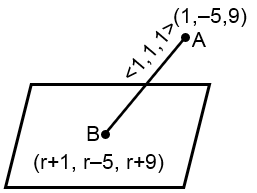Let two fair six‑faced dice A and B be thrown simultaneously. If E1 is the event that die A shows up four, E2 is the event that die B shows up two and E3 is the event that the sum of numbers on both dice is odd, then which of the following statements is NOT true?

E1 : {(4, 1), (4, 2), (4, 3), (4, 4), (4, 5), (4, 6)}
E2 : {(1, 2), (2, 2), (3, 2), (4, 2), (5, 2), (6, 2)}
E3 : {(1, 2), (1, 4), (1, 6), (3, 2), (3, 4), (3, 6), (5, 2), (5, 4), (5, 6), (2, 1), (2, 5), (4, 1), (4, 3), (4, 5), (6, 1), (6, 3), (6, 5)}
P(E1 E2) = = P(E1) P(E2)
⇒ E1 & E2 are independent
P(E2 E3) = = P(E1) P(E3)
⇒ E2 & E3 are independent
P(E1 E3) = = P(E1) P(E3)
⇒ E1 & E3 are independent
P(E1 E2 E3) = 0 P(E1) P(E2) P(E3).
⇒ E1, E2 & E3 are not independent.
Let's analyze the problem step by step. We have two fair dice, A and B, thrown simultaneously. The sample space has 36 equally likely outcomes (each die has 6 faces).
Define the events:
Now, check independence for each pair and the triplet. Recall: Events X and Y are independent if P(X ∩ Y) = P(X) × P(Y).
Step 1: Check E1 and E2 are independent?
E1 ∩ E2: Die A shows 4 and die B shows 2. Only one outcome: (4,2). So, P(E1 ∩ E2) = 1/36.
P(E1) × P(E2) = (1/6) × (1/6) = 1/36.
Since P(E1 ∩ E2) = P(E1)P(E2), they are independent. So, the first statement is true.
Step 2: Check E1 and E3 are independent?
E1 ∩ E3: Die A shows 4 (even) and sum is odd. So, die B must show odd number (1,3,5). Outcomes: (4,1), (4,3), (4,5). So, 3 outcomes. P(E1 ∩ E3) = 3/36 = 1/12.
P(E1) × P(E3) = (1/6) × (1/2) = 1/12.
Since equal, they are independent. So, the third statement is true.
Step 3: Check E2 and E3 are independent?
E2 ∩ E3: Die B shows 2 (even) and sum is odd. So, die A must show odd number (1,3,5). Outcomes: (1,2), (3,2), (5,2). So, 3 outcomes. P(E2 ∩ E3) = 3/36 = 1/12.
P(E2) × P(E3) = (1/6) × (1/2) = 1/12.
Since equal, they are independent. So, the fourth statement is true.
Step 4: Check E1, E2, and E3 are independent?
For three events to be independent, we need:
(i) P(E1 ∩ E2) = P(E1)P(E2)
(ii) P(E1 ∩ E3) = P(E1)P(E3)
(iii) P(E2 ∩ E3) = P(E2)P(E3)
(iv) P(E1 ∩ E2 ∩ E3) = P(E1)P(E2)P(E3)
We already verified (i), (ii), (iii). Now check (iv):
E1 ∩ E2 ∩ E3: Die A shows 4, die B shows 2, and sum is odd. But sum=4+2=6 (even), so no outcome satisfies all three. Thus, P(E1 ∩ E2 ∩ E3) = 0.
P(E1)P(E2)P(E3) = (1/6)(1/6)(1/2) = 1/72 ≠ 0.
Since they are not equal, E1, E2, E3 are not independent. So, the second statement is NOT true.
Therefore, the statement that is NOT true is: "E1, E2 and E3 are independent."
Probability of Independent Events: Two events A and B are independent if and only if P(A ∩ B) = P(A) × P(B). For three events A, B, C to be independent, all pairs must be independent and also P(A ∩ B ∩ C) = P(A)P(B)P(C).
Sample Space for Two Dice: When two fair dice are thrown, the total number of outcomes is 36. Each outcome is equally likely with probability 1/36.
Sum of Dice: The sum of numbers on two dice can be even or odd. The sum is odd if one die shows an even number and the other shows an odd number.